Will I ever in my lifetime feel sure at spring? After decades of observation, I still find myself on pins and needles wondering about certain plants and events in the springtime. Shouldn’t this one be back up by now? Weren’t there more of that one last year—did I take some out or what happened? What I did last fall—has it helped or hurt?
One part of me wants to figure it out and stop this worrying and wondering. Another thrills at the suspense, grows on the nervous tension, and learns a bit each year. Here I’ll tell you about some of the recurring questions I’ve put to rest. If you are like me—in need of reassurance at this resurgent season—these things, at least, you can be sure of…
Assurance #1: The bees will be there—on time, every time
A garden’s bloom season may begin on a different calendar date each year, as winter wraps up early or late. Yet on the day the first flower opens in your garden, bees will be there to sip its nectar. I was awed by the bees’ appearance the first time I saw my earliest crocus (C. minimus) on its first day. Since then, having seen it happen many times, the awe has mellowed but never left me.
I am assured bees will find the first flower, or that aphids will appear on the first succulent spirea shoots, and locust plant bugs will emerge as their host plants break bud. Each insect species has honed its timing through thousands of generations, so that they dance to the same tune as the plants they depend upon.
In both plant and insect, internal meters begin to run at the freeze that ends one season, accumulating time toward the wake-up bell for the next. On each day that temperatures rise above 40, for however many hours they hover there, insect eggs and larvae move forward in their development and plant cells chip away at chemicals that built up during fall as insurance against any resumption of growth before a safe time. In a related heat-registry, overwintering adult insects reckon safe emergence time. We humans have observed and recorded this timing in total degrees and hours, and converted it to “degree days.” At agricultural university Extension offices where such information is vital, we start our own meters at fall’s end to mark these units of time and say, for example, “Ah ha, 220 degree days have accumulated. Usually that happens about May 7 but this year it’s early…at any rate, it’s now time to look for honey locust plant bugs appearing from their wintering state.”
It’s an exquisite timing, particular to every region and microclimate. Degree days stack up more quickly one block uphill from me in Jack’s yard, which sheds its cold air downslope to pool in mine. So his crocus may open sooner than mine, and so too will the bees wintering in niches in his yard.
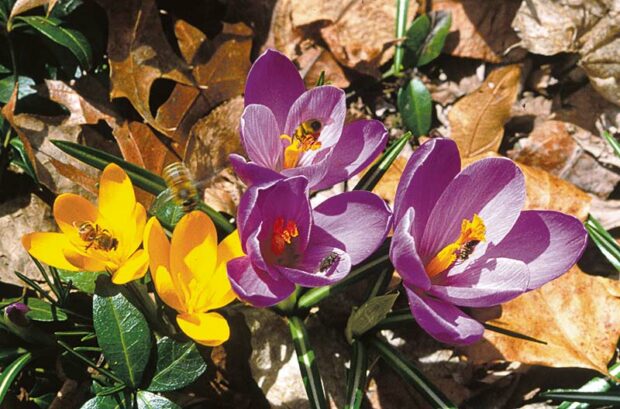
Assurance #2: Bugs will get ahead of you
So is it any wonder that even when we promise a favorite plant we’ll watch out for it next year, its predators find its new growth before we do? Insects and animals that rely on a plant are out there 24/7, awaiting or directly linked to their particular prey. As weekend warriors, we can’t beat that.
We can stay even by keeping sight of two facts, however. One, for most plant eaters, emergence coincides with their own plant’s new growth. Two, baby bugs are easier to kill than older, tougher individuals. Someone who told you they controlled aphids on a viburnum by, “just dousing it with the rinse water after I washed dishes,” was not telling tales even though this tactic may have failed in your yard. Apply soap (over-the-counter insecticidal soap spray or water plus dish soap) when the viburnum is just budding out and the day-old skins of its aphids will dry and split. Spray it on week-old aphids and those hardened veterans may break out loofah sponges and begin a chorus of Singin’ in the Rain.
Don’t let this news get you down. Most plants can manage despite the chewing, sucking or scraping of their usual predators. If they look worn or tattered as a result but have lost less than 20 percent of their leaf surface, they’ve suffered only cosmetic damage. That can be ignored or grown over. Meanwhile, insects such as ladybugs and lacewings that eat other insects are also engaged in the degree day dance. They’ll emerge in time to capitalize on their own prey’s development.
I do very little in the way of bug killing, but quite a bit of bug encouraging. That is, I avoid insecticide and allow insect-sheltering debris to overwinter in order to have the continued presence of species we recognize as beneficial insects. Out in a garden where hundreds or even thousands of insect species live, there are 8 or 9 species of beneficials for every 1 or 2 plant-damaging insect species. These good guys do little or no damage to plants—for instance, they may dine on pollen—but many attack, parasitize or eat other insects.
In addition, I keep my plants healthy by putting them where they can grow most vigorously. Such plants are better equipped to produce the distasteful, deterrent and downright deadly chemicals their species have devised to thwart their predators.
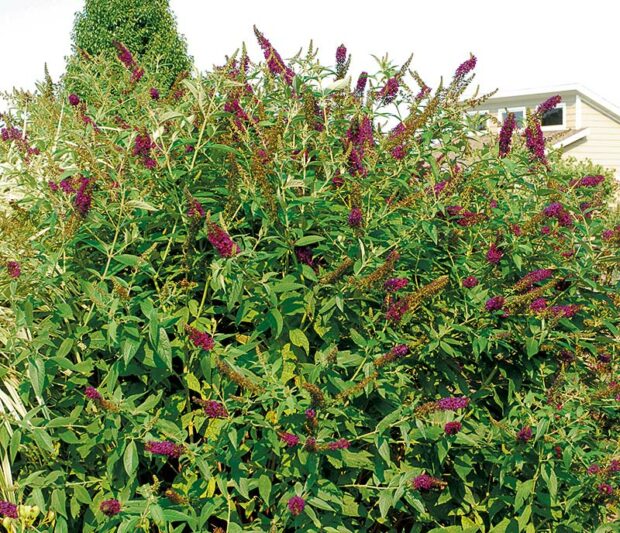
Assurance #3: Dead wood will fool the unsuspecting eye
As plants’ internally-concocted potions can dissuade insects and grazers, so can guilt turn people off from gardening. Don’t let it happen to you.
Lots of gardeners are more concerned about the damage they themselves have done, than what insects may do. “I pruned my butterfly bush at the wrong time and killed it,” is a common cry in this crowd. Let this spring mark the end of that lament, if it’s been voiced in your yard.
I can assure you that you cannot kill a butterfly bush (Buddleia davidii) by cutting it back in early spring, even to stubs an inch above ground, even removing all its wood that was beginning to bud out.
You can, however, cut a dead or dying butterfly bush and then blame yourself. If you’re in zone 5 or a warmer (higher number) zone and the bush was healthy last fall, it will be able to grow from one-inch stubs to 4 or 5 feet tall, and quickly, too.
If the bush is not healthy—particularly if it’s being grown in soil that’s overly moist or poorly drained—its crown and roots are susceptible to rot, which takes hold during winter and consumes the live tissue as spring ensues.
Another factor to consider is that some varieties of butterfly bush are not as hardy as others. In my experience, ‘Dark Knight’ is not to be trusted, whereas ‘Nanho Blue’ can probably handle even zone 4 cold if it’s given a well-drained, sandy site.
Roses prick gardeners with guilt too. I’ve watched for decades as roses are pruned at various times and stages of development, looking for proof that we “should not prune them too early.” In one instance, I checked in throughout the season on a public garden of several hundred roses pruned by a single horticulturist over a three-week period that included the “too early” days before forsythia bloom, and saw no ill effect.
As with butterfly bush, a rose may be dead or dying by pruning time. When we learn to look at the base of stems and crown of a shrub for signs of life such as moist, green cambium under the bark and white cores in branches, we will recognize deadwood when we cut it and be free of self reproach.
Assurance #4: Slow starters will start when you give up
Something else gardeners have a tough time accepting is the lateness of plants like hardy hibiscus (Hibiscus moscheutos), butterfly weed (Asclepias tuberosa), balloon flower (Platycodon), perennial ageratum (Conoclinium coelestinum), and groundcover plumbago (Ceratostigma plumbaginoides). These plants, big contributors to late summer bloom, all take their sweet time to emerge, avoiding the cold weather their new growth cannot tolerate by remaining dormant many degree days later than other plants.
So it’s a sure thing in spring that we will give up on one or another of these, give in to the urge to buy more plants, plant something “to replace” what we assume has failed, and soon after have two plants duking it out over the same space.
In fact, degree days may not be the only determinant of a slow starter’s emergence from winter rest. It could be that honest despair is a tonic to them, for they almost always pop up the day after a gardener has given up all hope, pouring his or her sense of loss down on that ground.
Ironically, this error can lead to a better garden. If you chance to buy the right type of plant and set it to grow where you believe the balloon flower or other supposed failure lies, you may produce a fine double-up. That is, if you plant an early riser that tends to nap through summer (early blooming bulbs, for instance), or a tap-rooted, spring-blooming species where a shallow-rooted character tallies (oriental poppy with hibiscus, for example), or a shallow-root spring bloomer with a deep-root sleepyhead (Sedum spurium with balloon flower), the two may go on happily for years together.
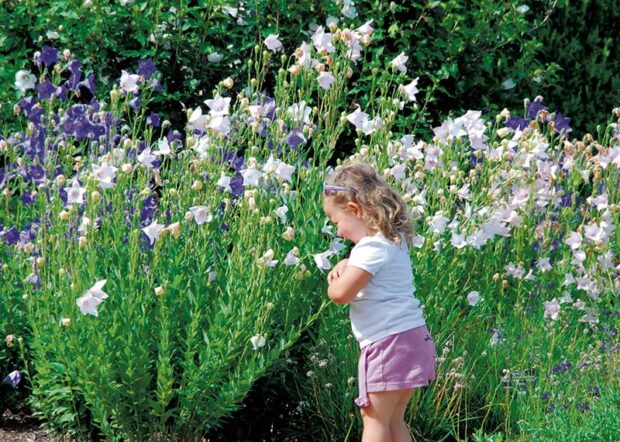
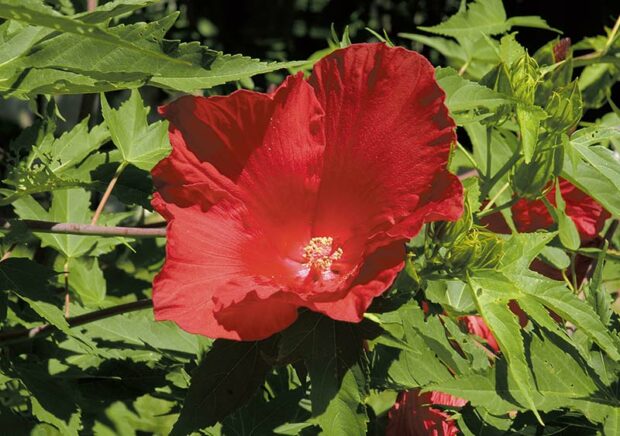
Assurance #5: You’ll estimate wrong about the mulch you need
Another thing that goes on for years is ordering too much or too little mulch. We might get it right at first guess, then think, “But didn’t I use that much last year, even before adding the two new beds?” Or we might announce our intention to another member of the household who undermines our confidence by asking, “That much? Are you sure you need that much?”
Since too much or too little is more rule than exception, cover your bases. When you have the mulch delivered, don’t let it be dumped right in front of the garage door. Not unless you want to hear long-suffering sighs from family members for weeks, along the lines, “I wishI could put my car in the garage!“
Likewise, in a move to ward off an unwelcome impact on your days that can follow the spreading of too little mulch, always begin mulching in beds that you see every day. Leave the farthest beds for last. Then, if the mulch runs out before all bare soil is covered, the exposed ground will not glare at you every day for the week or two that inevitably separates mulching opportunities one and two.
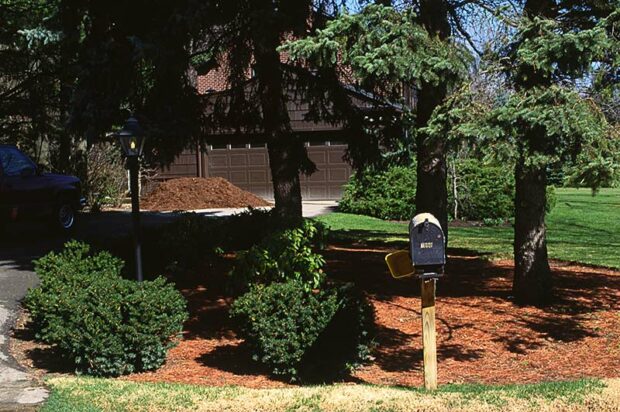
Assurance #6: The weather will conspire against you
One reason mulch follow-up rarely follows right on the heel of a mulch shortfall is the uncooperative nature of weather. If you chance to be gifted with a clear, cool day on the weekend or the day off work you chose for mulching, the next two picks you make will turn out to be filled with rain or sleet. Unless you garden in the Desert Southwest where weather reports are unnecessary because every day is sunny and dry, buy some rain gear. If you use it only once, you will still be glad. There’s a lot to be gained simply from telling the tale of working in the rain. Be sure to take a picture of you behind the wheelbarrow in the rain suit.
Another way that weather will do you in, but one in which you will probably be a co-conspirator, is in killing dahlias, elephant ears and caladiums. Although these roots you harvested last fall stored best through winter at 50 degrees, they won’t grow well now in soil that cool.
It’s a mistake to plant them outdoors before crabgrass season—about June 1 in my neighborhood—when the soil reaches 60 degrees. Once the tuber or corm you plant softens in the ground preparatory to sprouting, it’s susceptible to fungal attack in cold soil. Once the shoot begins to grow, the plant’s even more likely to be injured or infected. Such a plant may die, or limp into summer as a weakling.
If you’re itching to do something with those dahlia tubers or corms of elephant ear or caladium, divide any clumps now. Cut away any rotted sections. To be viable, a dahlia division must have a bit of last year’s stem included.
Then put just an inch of moist potting mix into a pot that’s eight inches deep or deeper, set the root in and add just enough potting mix to cover it. Put the pot in a warm place—no light needed—and check on it every few days. Your aim should be to keep it barely moist and to note when the shoot begins to grow. Once you see that, add more moist potting soil an inch at a time. Let the shoot show itself, cover it under an inch of potting mix, let it poke its tip up again and blanket it once more, until it reaches the top of the pot. Then put the pot into full sun. This process keeps you occupied for the last few weeks of unsettled weather and keeps the plant warm while it develops a stout shoot.
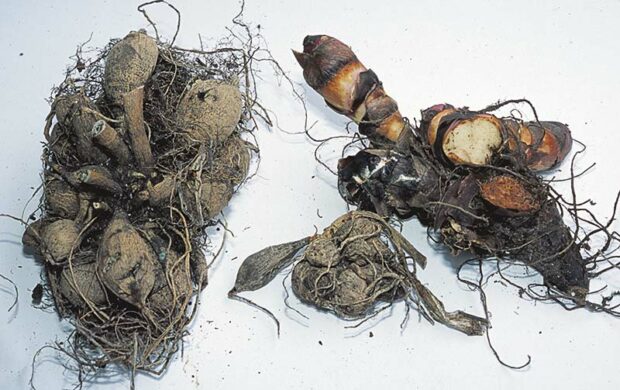
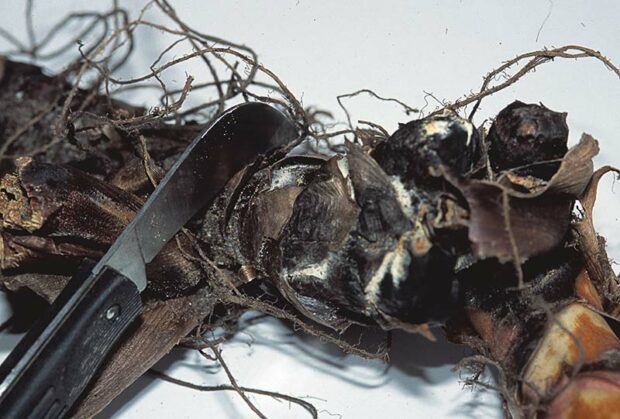
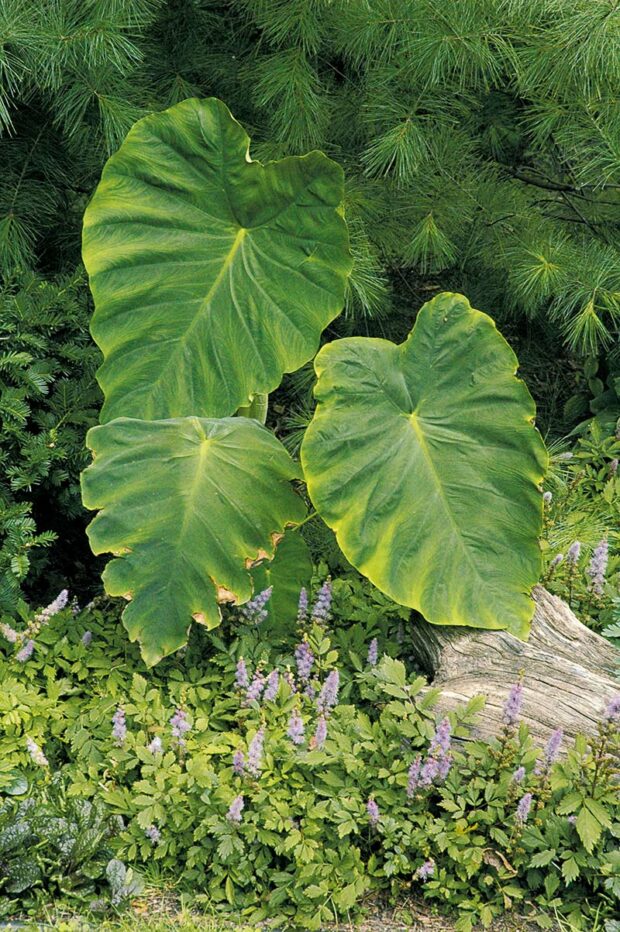
Assurance #7: Blue and pink hydrangeas will disappoint you
Hydrangea failure is another weather-plus-gardener problem. Mophead hydrangeas (H. macrophylla) are not reliably bud hardy in continental zone 5. That means their roots and sometimes their stems survive winter but the buds often do not.
The problem there is that this species spends the latter half of summer preparing a bud that will be in shape to finish its growth and bloom the following July. If those buds, located at the tips of branches, die or are cut off, the plant begins over again but flowering-branch development is a lengthy process. It is very unlikely the shrub will be able to produce a blooming shoot between now and when fall ends its season.
Sometimes winter kills the buds. You can tell right now if that happened. Consider yourself fortunate and the plant placed well if the bud at the tip of the branch is alive. You’ll know that’s the case if it’s plump and moist. Such a bud probably just pushed its protective scales aside to begin to grow again. If it’s dried out, dead or gone, don’t expect any bloom. Your placement of the plant is to blame. You can try shifting it to a spot in your garden where a warmer, more humid microclimate prevails in winter.
You see, even if a blue or pink hydrangea’s buds made it through winter, they’re not out of the woods yet. Weather steps to the fore. Often, as surviving buds open in spring, they’re killed by late frost. If that happens, loop back two paragraphs and read “If those buds…” because the weather’s kicked the plant back to that start-over point.
How is this dismal news reassuring? It is because it can save a gardener months of suspense that end in disappointment. Look now and be reassured by the condition of the tip buds whether there’s any chance for bloom. If there is, keep a cloth sheet on hand and cover the shrub to trap some ground warmth on frosty spring nights. If you’re attentive it may yet keep its tips and bloom.
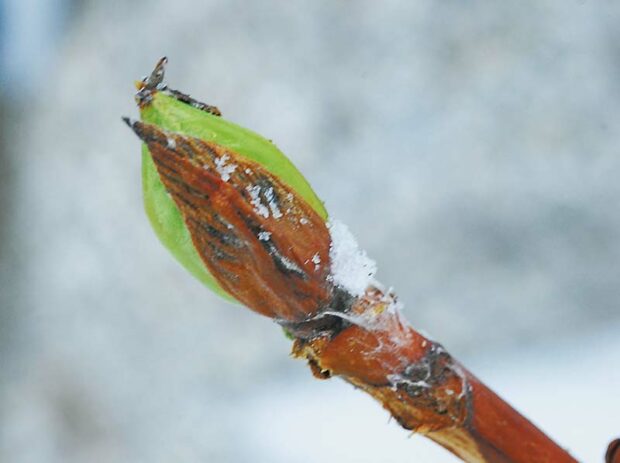
Final reassurance: Revelation will come
Whether it’s an “ah-ha” based on something you read in a magazine, a connection you make because your nose knows something about soil temperature that cannot be expressed in words, or the sounds you hear from birds reach a place in your conscious where natural cues rank themselves in mysterious but meaningful groups, you will learn and have fun this spring. I’m sure of it.
Article by Janet Macunovich and photos by Steven Nikkila, www.gardenatoz.com.
RELATED: Springboard into the garden season
